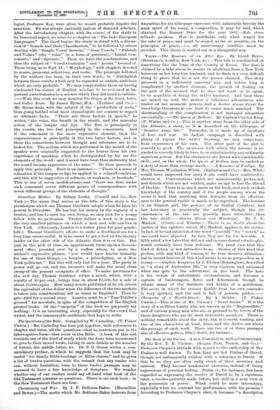Bounds and Inftexicnto in Greek and Latin. By J. C.
King, M.A., and C. Cookson, MA. (The Clarendon Press.)—This book is of a kind so elaborate, and in its way technical, that we cannot pre- tend to do it justice in these columns. The due appreciation of its merits must be left to journals which deal, so to speak, pro- fessionally with such works. We can do no more than indicate its scope and purpose. The first chapter is introductory. "The comparative study of language," say the authors, "is one of the youngest of sciences." It is not more than seventy years old. It began—and Englishmen may claim to be its originators—with the cljacovery of Sanscrit, though, indeed, if that eminent philo-
logist, Professor Key, were alive, he would probably dispute the assertion. He was always curiously jealous of Sanscrit scholars. After the introductory chapter, with its resume of the study in its historical aspect, we come to a chapter on "The Indo-European Languages." The third begins the study in detail with a discus- sion of "Sounds and their Classification," to be followed by others dealing with "Simple Vowel Sounds," "Semi-Vowels." "Palatals and Velars" (the " velar " is a form of guttural). "Labial Con- sonants," and "Spirants." Then we have the combinations, and then the subject of " Vowel-Gradation " and " Acceut " treated of. These bring us to Part II., "Morphology," with chapters devoted to nouns, pronouns, adjectives, and verbs. The principle followed by the authors has been, in their own words, to "distinguish between those results which may be regarded as certain, and those which are only probable." We may congratulate them on having vindicated the claims of English scholars to be reckoned as im- portant contributories to a science which they did much to initiate. —With this work we may mention The Origin of the Greek, Latin, and Gothic Roots. By James Byrne, M.A. (Tritbner and Co.)— Mr. Byrne deals with the subject of the "production of roots," thus going behind what most etymologists are content to regard as ultimate facts. "There are three factors in speech," he writes, "the voice, the breath in the mouth, and the muscular action of the tongue and lips. The first is principally in the vowels, the two last principally in the consonants. And if the consonant is the more expressive element, then the expressiveness is principally in the two latter factors, and in these the connections between thought and utterance are to be looked for. The actions which are performed in the mouth of the speaker were originally suggested to the hearer from his own experience of speaking, when he distinguished by his ear the elements of the word ; and it must have been thus indirectly that the sound became expressive of the sense." He then proceeds to apply this principle. Here is an instance :—" There is a sense of relaxation if the tongue or lips be applied in a relaxed condition, and this will be suggestive of softness, or weakness, or lassitude." This is one of seven modifications, and "there are thus under each consonant seven different points of correspondence with seven different groups of the elements of thought."



















































 Previous page
Previous page